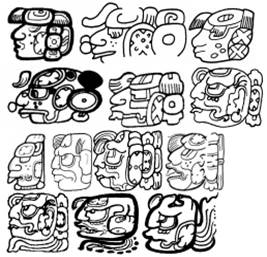![]()

![]()
![]()
![]()
K&H.p84.#7 K&L.p32.#1.14-16 [JM.p152.#2 = K&L.p32.#1.15] TOK.p8.r2.c6 MC.p164.r4.c6 MC.p164.r4.c7
K’INICH K’INICH K’INICH K’INICH K’INICH K’INICH.<[K’IN]chi>].ni
![]()
![]()


CPN Altar Q B5 CPN Altar Q F2 PAL TI Sarcophagus Lid 8 M&G.p142.3 = PNG St.3 C4
K’INICH.<YAX:K’UK’[MO’]> K’INICH.<YAX:K’UK’[MO’]> K’INICH.<JANAAB:PAKAL> K’INICH.<yo.<NAL:<o.AHK>>>
![]()
![]()
![]()
ZenderEtAl-SSw.p38.pdfp4.fig2b ZenderEtAl-SSw.p39.pdfp5.fig4a ZenderEtAl-SSw.p39.pdfp5.fig4b
YAX Lintel 58, E1-E2 YAX Lintel 2 J1-J2 YAX Lintel 52 I2-I3
che.<le:we> <CHAN:na>.K’INICH che.<le:we> <CHAN:na>.K’INICH che.<le:we> <CHAN:na>.K’INICH
![]()
![]()
![]()
![]()
M&G.p70.#4 = NAR Altar 2 B3-A4 M&G.p60.2 = M&G.p62.box M&G.p134.1.1
AJ.<wo:sa{l}> <CHAN:na>.K’INICH K’AWIIL.<CHAN:K’INICH> <che:le:we>.<CHAN:K’INICH>



K&L.p32.#1.1-13 (lost reference) (lost reference)
K’INICH K’INICH K’INICH:ni


![]()

TOK.p25.r1.c2 BMM9.p14.r6.c4 MC.p164.r4.c4 MC.p164.r4.c5
K’IN K’INICH K’IN/K’INICH K’INICH
· No glyphs given in BMM9.
· TOK.p25.r1.c2 reads this as only K’IN not K’INICH – one might think that it needs the two longish elements (one of them resembling the reduced form of ma) to read K’INICH (and without them, it’s just K’IN), but K&L have quite a few examples without it, read K’INICH.
· Variants (2):
o A. Stylized – two rectangular elements (either vertical or horizontal, but typically vertical):
§ Inside element (the K’IN and YAX-outline can be completely rectangular):
· K’IN in the centre.
· One arc on each end.
· One YAX-outline on the end of each arc, with a dot inside the YAX-outline, at the centre of the spot where the YAX-outline touches the arcs.
§ Outside element (optional):
· Reduced (bow-tie) variant of ma.
o B. God head:
§ Sometimes has one (very occasionally two) K’IN elements.
§ Optionally, the stylized variant on the right.
§ The whole glyph is just “K’INICH”, also when it consists of the head and the reduced variant.
§ Note that just the head alone can be used to write 4, and then it is read CHAN.

JM.p152.#4
LTI Kimbell Panel/unprovenanced E
<[K’IN]chi>:ni
· The K’IN can be infixed either in the bay formed by the thumb and the forefinger, or at the bottom (=on the back of the hand itself), replacing the partitive disk, but centred.